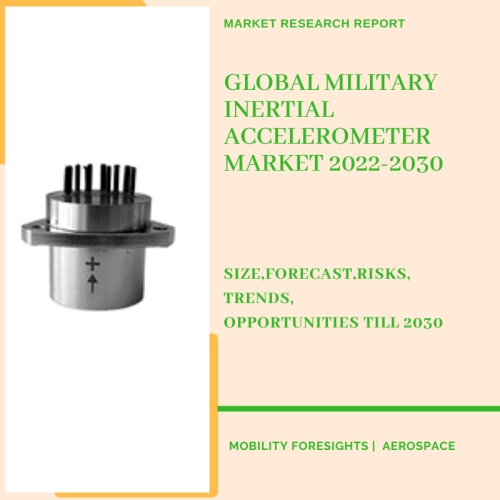
- Get in Touch with Us

Last Updated: Apr 25, 2025 | Study Period: 2022-2030
The inertial sensor, also referred to as the inertial navigation system (INS), measures the orientation of the spaceship with respect to the inertial system using an accelerometer and a gyro.
The carrier's motion acceleration is measured by the accelerometer, and the results are utilised to determine the airline's current location.
Electromechanical instruments known as accelerometers are capable of monitoring both static and dynamic acceleration forces.
Accelerometers can detect acceleration along one, two, or three axes. Due to the significant cost reduction, 3-axes devices are already becoming increasingly widespread.

The Global military inertial accelerometer market accounted for $XX Billion in 2021 and is anticipated to reach $XX Billion by 2030, registering a CAGR of XX% from 2022 to 2030.
G-ranges and end-user improvements have been added to Silicon Designs Inc.'s model 2227 MEMS inertial accelerometer series.
An end-user can increase the flexibility of the accelerometer voltage output at any given g-range by using the model 2227 series, which contains an integrated changeable scaling factor.
The circuit that transforms the MEMS accelerometer differential output voltage into a level of current directly proportionate to the amount of applied acceleration is built into each module and mounted on a high-temperature open printed circuit board.
The release of the navigation-grade accelerometer designed for high-performance applications, the iXal A5, has been announced by iXblue.
It is constructed using the Vibrating Beam Accelerometer (VBA) and Vibrating Inertial Accelerometer (VIA) concepts.
The sensor can be employed in a wide range of high-performance civil and defence applications, such as monitoring offshore drilling platforms and land, air, surface, and sea navigation.
| Market Segmentation |
| Scope of the report |
| Abbreviations |
| Research Methodology |
| Executive Summary |
| Introduction |
| Insights from Industry stakeholders |
| Cost breakdown of Product by sub-components and average profit margin |
| Disruptive innovation in the Industry |
| Technology trends in the Industry |
| Consumer trends in the industry |
| Recent Production Milestones |
| Component Manufacturing in US, EU and China |
| COVID-19 impact on overall market |
| COVID-19 impact on Production of components |
| COVID-19 impact on Point of sale |
| Market Segmentation, Dynamics and Forecast by Geography, 2022-2030 |
| Market Segmentation, Dynamics and Forecast by Product Type, 2022-2030 |
| Market Segmentation, Dynamics and Forecast by Application, 2022-2030 |
| Market Segmentation, Dynamics and Forecast by End use, 2022-2030 |
| Product installation rate by OEM, 2022 |
| Incline/Decline in Average B-2-B selling price in past 5 years |
| Competition from substitute products |
| Gross margin and average profitability of suppliers |
| New product development in past 12 months |
| M&A in past 12 months |
| Growth strategy of leading players |
| Market share of vendors, 2022 |
| Company Profiles |
| Unmet needs and opportunity for new suppliers |
| Conclusion |
| Appendix |